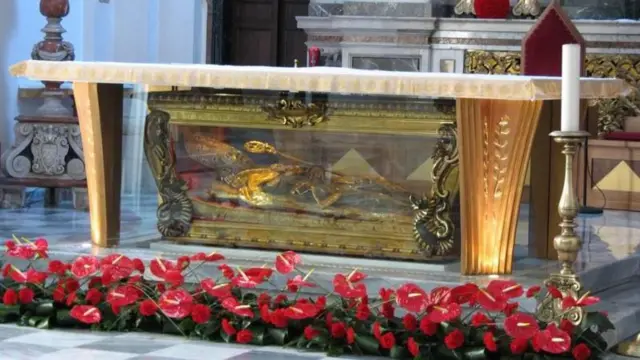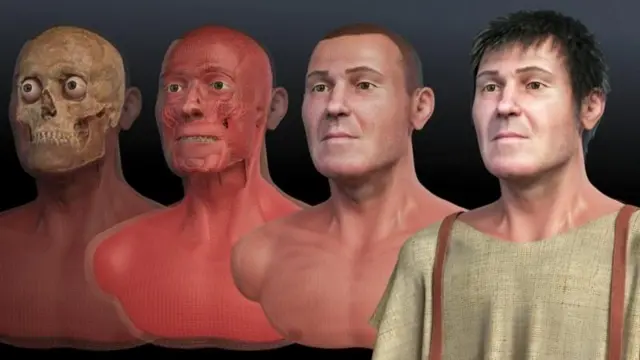When he was a Roman Emperor, Marco Aurelio Claudio (214-270) decided to prohibit the soldiers from marrying: he understood that a warrior without family ties was more brave, because he was less afraid to risk his life.
It is said that a bishop named Valentín, who believed in love, continued to celebrate the marriage ties between military, not respecting the imperial decree.
There are also reports from a religious called Valentín who distributed roses on the streets. And stories that say there was a Valentine who cut hearts of parchment and gave them to the soldiers, to look at those cards and remember their loved ones.
Or even the story that a Valentin priest contradicted influential family plans and, recognizing that there was a genuine feeling, agreed to formalize the union between a young Christian and his pagan girlfriend.
In the records of the Catholic saints, there are eleven called Valentín. And at least three of them – as the scholar of the hagiography Thiago Maerki, researcher at the Federal University of São Paulo (UNIFESP) and associates of the HagioGraphy Society, in the United States – are the protagonists of reports with love messages.
«These three characters are often confused, mix,» he emphasizes.

«The Valentine’s Day that celebrates the Church, the Valentine’s Day of Rome, has more to do with the history of a doctor who became a priest and, against the Emperor’s Law, continued to celebrate weddings between soldiers.»
«But your own existence is discussed,» he says.
If it is difficult to distinguish a Valentine’s Day from another, it is even more difficult to prove what really happened and what is nothing more than a legend built over the centuries.
And, as the figure held by Catholicism on February 14 is so rich in controversies, given the impossibility of confirming what is reality and what is myth, the Catholic Church itself was good to get it out of the traditional liturgical calendar in the 1960s, after the Second Vatican Council.
The masses in their honor ended up only in communities where tradition is strong.
Creation of myth
In the official church documents, the information is succinct and does not allow to differentiate a courage from another.
The Roman martyrology, where the biographies of the saints are found, is brief. On February 14, Valentine is mentioned, followed by the brief explanation that he was martyred «in Rome, in Vila Flaminia, next to the Milvio bridge.» Nothing else.
«The missal before the Vatican Council II also does not give details, but indicates that Valentín was a priest and martyr, and that his martyrdom occurred around 270,» says the researcher and student of the life of the saints José Luís Lira, professor of The State University of the Acaraú Valley, in Brazil.

He explains that what the imaginary on Valentine was «ended up being» oral and written literature. «
«Around them legends are being created, as was the custom of these first Christians. The voice of the town was the one that celebrated their saints. And these cults, popular traditions, gain strength in the Middle Ages. Until what was not official, until it was recognized by the Church, which has no choice but to assume tradition as an officer, ”says Maerki.
Behind the sources
Amid so many contradictions, the conductive thread of what could have been the true Valentine’s Day is the information that ends up being confirmed by different sources.
Thus, it is possible to locate the saint of love as someone who lived in Rome in the third century of the current era and collided with the government of Emperor Claudio. It is also consistent with the existence of the Milvio bridge, on the Tiber River, mentioned in martyrology.
«It is approximately 207,» Lira emphasizes. «It is cited during the Second Punic War, on the occasion of the return of the battle of Metauro».
It also makes sense to believe that he was martyred, since this destiny was common for prominent Christians of his time, when Rome saw that group as a threat to order.

The date of February 14 as a date of his death is possibly a late invention. A convenient invention, by the way, in a process imposed by the Church, when it became an official religion, from the fourth century, with the aim of systematically absorbing and resigning pagan practices.
«Even with the already official Christianity, initially the rituals called pagans, of the Romans,» says Vaticanist Filipe Domingues, a doctor from the Gregorian University of Rome and deputy director of the Lay Center of Rome.
«The church of that time gradually created parties, memories and practices to suppress even pagan practices. The temples became churches, and the rituals began to resignify, ”he adds.
Therefore, in the year 496, Pope Gelasio I (410-196) established that Valentine’s Day should be held on February 14. The idea was not accidental.
The pagan festival
During this period, approximately one month before the beginning of spring in the northern hemisphere, ancient Rome had a festival called Lupercalia, a ritual for fertility.
«It was a time when people got together intimately, sexually, like a religious ritual. The period also indicated the beginning of planting and requested the blessing of the gods to be a fertile year, with a lot of production », contextualizes Sunday.
The Pope wanted to frame what already existed within Christian morals.
«He wanted to end that and then needed to create a Christian identity for the ritual. He put Valentine’s Day as the patron of lovers, of the couples, ”says the Vaticanist.

«The Church did not completely abandon existing practices but also aligned them, tried to put a Christian justification for social rites and relations that were typically pagan.»
In this sense, Domingues comments that Valentín’s choice could have been random.
«There is no reason where we know,» he says. And it is possible that later legends have been created from love stories.
«It was at that time that the memory of Valentine began to associate with the idea of a saint of love, a patron saint of lovers,» says Maerki.
«The Church instituted Valentine’s Day by promoting a Christian response to an ancient tradition,» summarizes historian Denise Wanderley Paes de Barros, professor at the Mackenzie Presbyterian University.
The popular date
The date is thus seen in much of the world and exploited by merchants and restaurants owners.
«Interestingly, what was born as a pagan party and was then absorbed by Christianity, today has once again been a secular celebration,» says Domingues. «The name of the saint is used, but it is no longer a Christian party.»
What happened is that Valentín’s biographical construction is most likely – or the Valentines’ set – was full of fiction.
And from the Second Vatican Council, there was an effort of the Church «to eliminate the memory of saints that would have a possibly legendary origin; That is, they were nothing more than a mythological construction, ”explains Maerki.

«During the council the need to confirm the existence of certain saints was discussed,» says Lira.
«As a result, some turned the mandatory celebration into optional. Saint Paul VI (1897-1978), Pope, in 1969, he reformed the calendar for the celebration of the saints and the Valentine’s memory became optional ».
«This was mainly due to the existence of more than one Valentine in martyrology and without many details regarding its existence. The martyrdom act was in charge of each church, so it was not possible to give full truth to the data, ”adds the hagiologist.
Much later, there was a concern to have a greater criteria to declare himself Christian.
Maerki comments that it is «very difficult to say that Valentine’s Day did not exist» simply because «as a memory, at least, it existed and exists, since until today it is celebrated by many groups within the Church.»
Paes de Barros adds that, at that time, «the Catholic Church realized that all of them (the Valentine) lacked historical value.»
When analyzing the documentation and reports available, historical discrepancies and coincidences were noted in figures buried in different places, for example.
Pilgrimage sites
But if the saints’ tombs end up being points of religious pilgrimage, there are at least three important places in Italy when you think of Valentine’s Day.
In Rome, the Basilica of Santa Maria In Cosmedin keeps a skull attributed to Valentine’s Day.
The corresponding remains are found in the Basilica of Valentine in the city of Terni; One of the historical figures that would become Valentine’s Day was Bishop of Interamna, now Terni, in Umbria.
Also in Italy, the Church of San Jorge, in Monselice, in the province of Padua, has a sepulcher with mortal remains attributed to another of the Valentine.
Specialist in the facial reconstruction of saints and other ancient personalities, Brazilian designer Cíero Moraes recreated both Valentine in 3D, from images of their well -preserved skulls.
https://dolartoday.com/wp-content/uploads/2025/02/San-Valentin-historia.jpg
#Love #Day #Valentines #legend #arose #saint #celebrated #February #existed
Source link
 Latest Breaking News Online News Portal
Latest Breaking News Online News Portal

